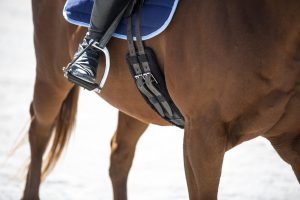What is softness in a horse, and what does it mean to be “soft” or “light” in the bridle? This is an important concept to understand because done correctly it can solve many training issues, create a horse that is more pleasant to ride, and even reduce the chance of injury or lameness.
Softness starts with a willing attitude, a relaxed eye, and a relaxed body. From there we teach the horse to give easily to small amounts of pressure, thus creating the “light” feeling. With a soft horse, we can work on rhythm and suppleness, the first two parts of the dressage training scale.
Softness is the opposite of braced. A horse may give to bit pressure by moving his nose, and or “breaking at the poll,” but that is not soft, because he is likely still tight and stiff through his neck and back. True softness means that the horse’s whole body is relaxed as he gives to pressure. Working and training in this way promotes proper self-carriage in the horse which will keep his body strong and healthy. Just as with people, relaxed, supple muscles will decrease the likelihood of an injury.
What I am describing in today’s post is not just for dressage riders or advanced riders. Even if you are content with taking your horse for the occasional trail ride you will have a happier, less oppositional partner on the trail if you spend some time softening. Also, if you are a new rider, the softening exercise I am going to show you in the video is an excellent way to develop your feel and timing, which means learning when to hold, when to release, and how much pressure is appropriate.
So where does this start? Well, that is where this week’s video comes in! To be clear, softness starts with the horse’s state of mind. If you are introducing this for the first time you will be more successful if you start with a horse that is already relaxed and calm. After your horse is familiar with this work, the softening exercises can relax and focus him by themselves.
I like to start teaching a horse to give to pressure in a rope halter, working on lowering the head and neck with a downward pull on the nose. With a green horse this will often start by taking the nose side to side first, having the horse soften laterally before down. The goal is to have the horse stretch his neck to give to the pressure, not just move his nose back. After I have my horse soft in the halter, then I will move on the bridle, then to going forward and holding the head down position (still on the ground), and then I will repeat the process from the horse’s back. The fun really starts as you ask for more movement, transitions, lateral work, etc while maintaining that soft, light feeling in your horse.
The video below is going to show the first step of teaching your horse to give to pressure from the rope halter and bridle. I show this with Whoopie Pie, a little paint mare who tends to be quite nervous, tense, and stiff, and loved to pull at the bit, so hit play below and enjoy! After watching the video, leave a comment and tell me if you have any questions or any other softening exercies you would like to share!













2 Responses
Once you get spoiled to riding a soft, light horse, you will never want to go back. The halter is the perfect way to work on softness for most horses and leaves you with a horse that can be ridden in a halter.